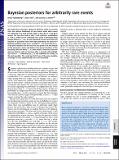| dc.contributor.author | Fudenberg, Drew | |
| dc.contributor.author | He, Kevin | |
| dc.contributor.author | Imhof, Lorens A. | |
| dc.date.accessioned | 2018-01-19T20:28:12Z | |
| dc.date.available | 2018-01-19T20:28:12Z | |
| dc.date.issued | 2017-03 | |
| dc.date.submitted | 2016-11 | |
| dc.identifier.issn | 0027-8424 | |
| dc.identifier.issn | 1091-6490 | |
| dc.identifier.uri | http://hdl.handle.net/1721.1/113241 | |
| dc.description.abstract | We study how much data a Bayesian observer needs to correctly infer the relative likelihoods of two events when both events are arbitrarily rare. Each period, either a blue die or a red die is tossed. The two dice land on side 1 with unknown probabilities p[subscript 1] and q[subscript 1], which can be arbitrarily low. Given a data-generating process where p[subscript 1] ≥cq[subscript 1], we are interested in how much data are required to guarantee that with high probability the observer's Bayesian posterior mean for p[subscript 1] exceeds (1-δ)c times that for q[subscript 1]. If the prior densities for the two dice are positive on the interior of the parameter space and behave like power functions at the boundary, then for every ϵ > 0; there exists a finite N so that the observer obtains such an inference after n periods with probability at least 1-ϵ whenever np 1 ≥N. The condition on n and p[subscript 1] is the best possible. The result can fail if one of the prior densities converges to zero exponentially fast at the boundary. | en_US |
| dc.publisher | National Academy of Sciences | en_US |
| dc.relation.isversionof | http://dx.doi.org/10.1073/pnas.1618780114 | en_US |
| dc.rights | Article is made available in accordance with the publisher's policy and may be subject to US copyright law. Please refer to the publisher's site for terms of use. | en_US |
| dc.source | PNAS | en_US |
| dc.title | Bayesian posteriors for arbitrarily rare events | en_US |
| dc.type | Article | en_US |
| dc.identifier.citation | Fudenberg, Drew, Kevin He, and Lorens A. Imhof. “Bayesian Posteriors for Arbitrarily Rare Events.” Proceedings of the National Academy of Sciences 114, no. 19 (April 25, 2017): 4925–4929. © 2018 National Academy of Sciences | en_US |
| dc.contributor.department | Massachusetts Institute of Technology. Department of Economics | en_US |
| dc.contributor.mitauthor | Fudenberg, Drew | |
| dc.relation.journal | Proceedings of the National Academy of Sciences | en_US |
| dc.eprint.version | Final published version | en_US |
| dc.type.uri | http://purl.org/eprint/type/JournalArticle | en_US |
| eprint.status | http://purl.org/eprint/status/PeerReviewed | en_US |
| dc.date.updated | 2018-01-17T12:38:11Z | |
| dspace.orderedauthors | Fudenberg, Drew; He, Kevin; Imhof, Lorens A. | en_US |
| dspace.embargo.terms | N | en_US |
| mit.license | PUBLISHER_POLICY | en_US |
